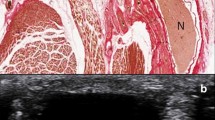Summary
The authors report on 14 patients in whom cerebral tissue pressure was recorded after operation for brain tumours. Cerebral tissue pressure was recorded by a 5 French catheter with two microtransducers. The transducers were placed intraoperatively in the wall of the tumour cavity and in a distance of approximately 2.5 cm.
Differences between both pressures from 4 to 28 mmHg were observed. They were higher in patients with glioblastomas and meningiomas than in patients with intracranial metastases. In 7 patients proximal tissue pressure was higher than distal. In 4 patients the contrary was observed. Discussing the literature the authors think intrahemispheric changes of brain water content, blood flow, and brain tissue elastance to be responsible for this phenomenon.
Similar content being viewed by others
References
von Bergmann E (1985) Über den Hirndruck. Arch Klin Chir 32: 705–732
Brock M, Pöll W, Furuse M, Dietz H (1973) Der „Docht-Katheter”; ein neues Verfahren zur postoperativen Überwachung des intrakraniellen Druckes. Acta Neurochir (Wien) 28: 201–212
Cervós-Navarro J, Ferszt A, Artigas Jet al (1980) A modified method for monitoring intracerebral pressure in brain edema. In: Cervós-Navarro J, Ferszt A (eds) Brain edema, Advances in Neurology, vol 28. Raven Press, New York, pp 27–38
Cushing H (1902) Some experimental and clinical observations concerning states of increased intracranial tension. Am J Med Sci 124: 375–400
Ecker A (1955) Irregular fluctuation of elevated cerebral fluid pressure. Such fluctuations as a measure of dysfunction of cerebrovascular episodes, pseudotumour cerebri, and head injury. Arch Neurol Psychiat 74: 641–649
Flexner LB, Clark JH, Weed LH (1932) The elasticity of the durai sac and its contents. Am J Physiol 101: 293–303
Guillaume J, Janny P (1951) Manométrie intra-cranienne continue: intérét physio-pathologique et clinique de la méthode. Presse Med 59: 953–955
Ianotti F, Hoff JT, Schielke GP (1985) Brain tissue pressure in cerebral ischaemia. J Neurosurg 62: 83–89
Langfitt TW, Weinstein JD, Kassell NFetal (1964) Transmission of increased intracranial pressure. I. Within the craniospinal axis. J Neurosurg 21: 989–997
Langfitt TW, Weinstein JD, Kassell NFet al (1964) Transmission of increased intracranial pressure. II. Within the supratentorial space. J Neurosurg 21: 998–1005
Leech PJ, Miller JD (1974) Intracranial pressure-volume relationships during experimental brain compression in primates. J Neurol Neurosurg Psychiat 37: 1093–1098
Lundberg N (1960) Continuous recording and control of ventricular fluid pressure in neurosurgical practice. Acta Psychiat Scand 36 [Suppl] 149, idem Munksgaard, Copenhagen
Miller JD, Garibi J (1972) Intracranial volume/pressure relationships during continuous monitoring of ventricular fluid pressure. In: Brock M, Dietz H (eds) Intracranial pressure. Experimental and clinical aspects. Springer, Berlin Heidelberg New York, pp 270–274
Miller JD, Leech PJ, Pickard JD (1975) Volume pressure response in various experimental and clinical conditions. In: Lundberg N, Pontén U, Brock M (eds) Intracranial pressure II. Springer, Berlin Heidelberg New York, pp 87–100
Piek J, Kosub B, Küch F, Bock WJ (1987) A practical technique for continuous monitoring of cerebral tissue pressure in neurosurgical patients. Preliminary results. Acta Neurochir (Wien) 87: 144–149
Reulen HJ, Graham R, Spatz Met al (1977) Role of pressure gradients and bulk flow in dynamics of vasogenic brain edema. J Neurosurg 46: 24–35
Reulen HJ, Kreysch HG (1973) Measurement of brain tissue pressure in cold induced cerebral edema. Acta Neurochir (Wien) 29: 29–40
Weaver D, Winn HR, Jane JA (1982) Differential intracranial pressure with mass lesions. J Neurosurg 56: 660–665
Weinstein JD, Langfitt TW (1967) Responses of cortical vessels to brain compression; observations through a transparent calvarium. Surg Forum 18: 430–432
Wolff HG, Forbes HS (1928) The cerebral circulation. V. Observations of the pial circulation during changes in intracranial pressure. Arch Neurol Psychiat 20: 1035–1047
Author information
Authors and Affiliations
Rights and permissions
About this article
Cite this article
Piek, J., Plewe, P. & Bock, W.J. Intrahemispheric gradients of brain tissue pressure in patients with brain tumours. Acta neurochir 93, 129–132 (1988). https://doi.org/10.1007/BF01402894
Issue Date:
DOI: https://doi.org/10.1007/BF01402894




